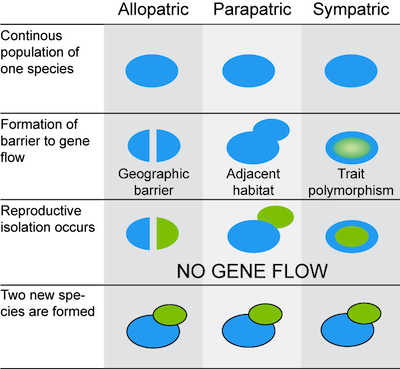Common Mistakes
What is a Species
Sometimes the difference between a subspecies and a species can seem a bit fuzzy, because there's really no clear biological delineation between them.A species is a group of individuals that can potentially interbreed and share genes. Subspecies are included in this definition because of the word potential. Subspecies can potentially interbreed with other members of the species, but for practical reasons (usually geographic) they don't. It's a can vs. do situation.
Species Concepts
Species requirements of the BSC:• Species are groups of organisms that can interbreed
• The must be natural populations
• There must be no gene flow (not just no direct mating)
• No hybridization is allowed, unless hybrids are infertile and/or inviable
What is speciation?
There are four modes of evolution that can be demonstrated by a phylogenetic tree, and speciation is only one of them:Anagenesis—the evolutionary changes that occur within a species over time
Cladogenesis (aka Speciation)—the splitting of one lineage into two
Extinction—the ultimate evolutionary change. Now you're here. Now you're gone.
Stasis—when not much change is occurring in a lineage over time, it's just doing its thing being a species.
Reproductive Isolation
Keeping your postzygotics and prezygotics straight can be tricky. It's tempting to equate prezygotic with any type of pre-mating barrier, and postzygotic with all the post-mating barriers. If this is helpful for you than go for it, just remember the one important exception: gametic isolation. Since mating actually occurs but a zygote is never formed because of problems with the gametes, it's the only pre-zygotic, post-mating barrier.Geography of Speciation
All these -patry's, how to keep them straight? Remembering root word helps (allo=different, sym=same), but nothing beats a visual:
Bring in the Reinforcement
Reinforcement is the process in which natural selection leads to reproductive isolation between two species. It can seem tricky, but it has three simple steps:Reduced hybrid fitness > Natural selection favors assortative mating > Reproductive Isolation
1) Reduced hybrid fitness: Hybrids are less fit than parent species, usually because of their intermediate phenotype
2) Natural selection favors assortative mating (the tendency for like to mate with like). The parents are actively selected for if they mate with their own type and selected against if they mate with other types. Therefore, reinforcement is an active (rather than passive) evolutionary process
3) Once assortative mating is an established trait in the parent species, there is no gene flow between them—bingo. Reproductive isolation.
Tempo of evolution
Wait, what are incipient species?Incipient species are when two groups are beginning to diverge, but there is not yet complete reproductive isolation between them. Incipient speciation is the very beginning stage of the speciation process, and biologists love to look for evidence of incipient speciation occurring right under our noses.
Adaptive Radiation
What makes adaptive radiation so special? That is to say, why is it any different from all the other examples of organisms adapting to their environments with generally successful results?There are few things that make adaptive radiation different than just environmental adaptation. First, all the species involved are descended from a common ancestor, which likely had very different habitat requirements than its descendants. Second, adaptive radiation doesn't just result in organisms being well matched to their environment; it results in the generation of new species. Third, the process is relatively fast, compared to background rates of speciation for a given lineage.
Hybridization vs. Hybrid speciation
Getting them confused? It helps to remember that hybridization is pretty common while hybrid speciation is pretty rare. Most of the time we're talking about hybridization. Plus, even though their names are similar, they have drastically different results:Hybridization: This occurs when two species merge into one. According to the BSC, this suggests they were one species all along.
Hybrid Speciation: This occurs when two species become three: the two parent species plus a new hybrid species. The new hybrid species can mate with other hybrids, but is reproductively isolated from the parent species.